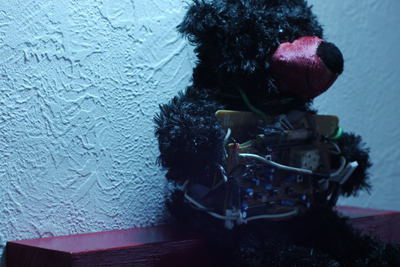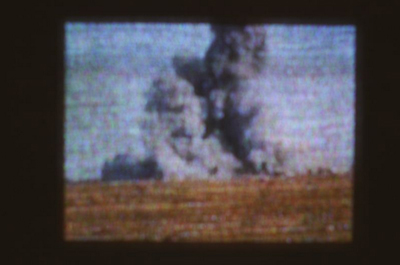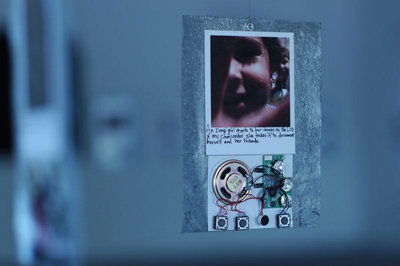This article, written by Joseph Carmen, is copied from the 555 Collective website in anticipation of the work of Folleh Tamba, 2014 Interdisciplinary Arts & Media MFA, being shown in the “What is War? ” exhibition in St Francis, Kansas, opening July 3, 2014.
Folleh Tamba’s “A Grunt’s War Diary” seems to be a unique moment in the history of art and war. An installation that allows the viewer to experience the viscera of combat via direct documentation – to touch, hear, and see actual elements of war – visual, audio, and tangible artifacts – sculpture, poetry, and photography – all presented as a whole that places us inside the subconscious of a combat veteran, before, during, and after his repeated deployments to Iraq and Afghanistan.
Tamba was born in the United States, and moved with his parents to West Africa when he was five-months old. He obtained his first AK-47 at the age of eight, to protect himself during the Liberian civil war. He sold cigarettes during the day, so that his family could eat at night. The Liberian rebels destroyed everything that his family owned, forcing them into a refugee camp rife with disease and violence. Tamba’s mother found a way to bring her the family back to the U.S., where he returned at the age of 18, unable to speak English at the time.
Tamba went on to obtain separate bachelor’s degrees in Justice Studies and Film. Out of appreciation for his newfound country and respect for the United States Marines who helped his family find refuge in Liberia, he enlisted in the Corps in the summer of 2000. He was deployed to the conflicts in Iraq and Afghanistan a total of seven times between 2003 and 2011. During these deployments, Tamba was permitted by his commanding officer to document his experience with a digital video camera. After his personal camera was destroyed by an IED blast, his platoon sergeant (Staff Sergeant Edward Corral) provided Tamba with a second camera, urging him to continue his work.
Tamba returned from his final deployment in possession of between seven and eight terabytes of digital files – video, audio, stills, and a diary filled with poetry and prose. Utilizing the GI Bill, he obtained a Master of Fine Arts degree in Interdisciplinary Arts and Media from Columbia College in Chicago, graduating in May of 2014.
“A Grunt’s War Diary” provides an intensive study of the mind of a man whose life is epitomized by the one word that seems to have captivated and horrified humanity from its nascent stages – Trauma. The installation marks the end of an era characterized by darkness and pain in Tamba’s path, while opening the door for not only him, but all who experience his work, to search unchartered routes in this existence that point us in the direction of hope.
Tamba has struggled with the mundane and redundant aspects of our culture since his return from war, as have all of our veterans with similar experiences. He speaks of a loss of purpose, of alienation from normalcy – he recalls only fragments of his life prior to combat – the toll of multiple IED blasts having eroded his ability to process basic day-to-day information.“Everything before war becomes irrelevant,” Tamba says, “It’s like your old life has been wiped away. The new memories overpower the old.”
“A Grunt’s War Diary” is a work with immense emotive energy that will educate and create true empathy for the men and women who have fought on all sides in all wars. It is not only profound, but also necessary for this time in our history. Our culture errs when it pities or patronizes our veterans of war. While they do require our assistance and embrace, they also possess valuable information that can guide us all through the shared struggle of human consciousness.




